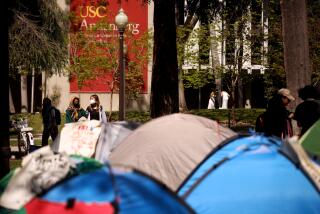Campus Gets Section of Berlin Wall
- Share via
It may be one of the ugliest monuments to freedom ever commissioned.
But when a graffiti-scarred slab of the Berlin Wall is resting in a reflective pond at Chapman University at the end of the year, it will symbolize the 50-year history of the Cold War to thousands of students.
Most of them will know that the 26-mile-long wall--built of concrete, steel bars and barbed wire--was built in 1961 to keep Communist East Germans from defecting to democratic West Berlin.
More than 1,000 people had escaped to the west since Germany and Berlin were divided between the Communist and Western powers at the end of World War II. After the wall was built, 170 people were shot down by border guards as they tried to climb it.
In 1989, Germany began to reunify and to dismantle the wall. Some pieces were used in road projects, but slabs went to museums, universities or other civic groups.
One 9-foot-high chunk arrived at the school Monday on the back of a flatbed. Its arrival ended a two-year journey that began when Chapman President Jim Doti saw a similar slab at the Ronald Reagan Library in Simi Valley and decided he wanted one for the campus.
“It’s a symbol of the end of the Cold War and a symbol of freedom,” said Doti, who stood in the parking lot Monday with trustees, students and others waiting for the delivery. “I was asking students about it and they said, ‘We were just little kids when this came down.’ Well, I was just a little kid when this went up.”
The letter from Berlin confirming the wall piece came about six months ago, after Doti had buttonholed Rep. Christopher Cox (R-Newport Beach) at a dinner party. Cox lobbied on the university’s behalf. But the university had to get the slab to Orange.
W. Guy Fox, chairman of Redondo Beach-based Global Transportation Services Inc., stepped in to help. His company donated all but about $5,000 in shipping and freight costs to the cause; Long Beach’s California Cartage Co. Inc., which transported the wall section to Chapman, also donated its services.
Both companies saw it as a humanitarian gesture and workers at the Port of Long Beach reportedly grabbed their cameras to record the arrival.
At Chapman, Gary Caton, a 39-year-old finance professor, recalled “sitting alert” for the U.S. Air Force when the Cold War was in full swing.
“I remember Ronald Reagan standing at this wall and saying, ‘Mr. Gorbachev, tear down this wall,’ ” he said “And now a piece of it is sitting in our backyard.”
Adrian Craciun, a 21-year-old transfer student who grew up in Soviet-bloc Romania, said he fully appreciated the symbolism of the wall.
“The way I see it, this is a symbol of barriers,” he said. “A symbol of the elimination of barriers and the trend of international consensus. It is a really thrilling feeling.”
More to Read
Sign up for Essential California
The most important California stories and recommendations in your inbox every morning.
You may occasionally receive promotional content from the Los Angeles Times.













